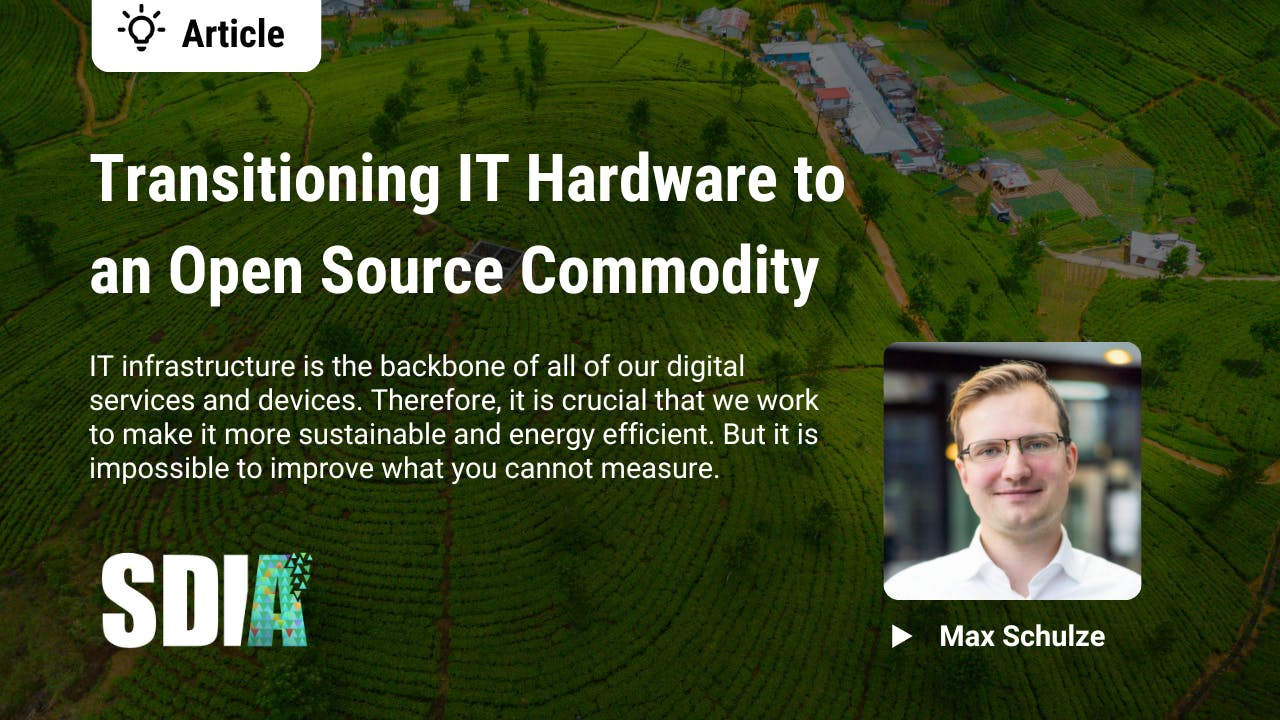Executive Summary
- A sustainable digital future that balances the environmental, societal and economic needs of society must be rooted in humanity-driven values. To achieve this, it needs to be built on sustainable digital infrastructure. We aim to create a space for dialogue and informed debate where society, policymakers, and the digital sector can discuss and envision what this digital infrastructure should look like - moving towards sustainable, open and transparent digital infrastructure.
- Society is embarking on a twin transition toward sustainability and digitalization. While the rapid expansion of the digital sector and cloud computing has led to significant benefits (increased connectivity, innovations and efficiency), the concentration of power within the digital sector int the hands of a few corporations undermines our values.
- While digitalization brings opportunities to address many of the world’s pressing problems, the disparity in control and power within digital infrastructure undermines human-centric digitalization and promotes a ‘digitalization-at-all-costs’ mindset. The market is highly concentrated, making it difficult for regional or national competitors in digital infrastructure to gain market share. Dominated by a few oligopolies like AWS, Google Cloud, and Azure, it is virtually impossible for smaller regional providers to enter.
- The current cloud landscape is highly dominated by non-European companies, leading to dependency on global actors. In this way, European companies are essentially funding foreign innovation through an indirect ‘cloud tax’ paid by utilizing the digital infrastructure of foreign entities. This threatens our ability to embed our values and societal priorities into the infrastructure that powers digitalization of our economy.
- We promote the concept of regionality, where a region is defined as any cities, municipalities, and communities willing to collaborate on a shared digital infrastructure. This approach ensures that digital infrastructure is tailored to local needs and supports local economies.
How did a few digital service companies come to dominate the market for digital infrastructure?
The dominance of Amazon Web Services (AWS), Google Cloud Platform (GCP) or Microsoft Azure is not accidental. Launched in 2006, AWS was one of the first major cloud service platforms, which allowed them to set industry standards and build a broad customer base. Google Cloud Platform leveraged their expertise in data centers and large-scale data processing. Microsoft Azure built on Microsoft’s reputation and expertise in the enterprise software industry and was launched in 2010.
To offer on-demand digital resources (offering hour-by-hour renting of ICT equipment) requires large-scale, long-term investments. Digital conglomerates such as Microsoft, Amazon or Google are vertically integrated companies, each have their own cash-flow generating core business activities which they use to fund the long-term investments in digital infrastructure. For Google, it’s advertising, for Microsoft software licensing, and for Amazon it’s an e-commerce marketplace.
This vertical integration enables them to deploy capital to buy ICT equipment in large quantities, reducing purchasing costs, and then lease it to customers as an operational expense. This minute-by-minute renting creates a significant risk of idling units, a risk that other providers without a large enough balance sheet cannot absorb.
The rental agreements are demand-based and allow customers to rent on an hourly or even minute-by-minute basis. The risk of idling units occurs when rental units are not being used, hence are not generating any revenue. Providers must still cover the costs of maintaining these units without earning any revenue during idle times. Only providers with substantial financial resources can mitigate this risk through scale, but smaller providers with less financial flexibility may struggle to sustain their operations when units remain idle for too long.
With their willingness to put ICT equipment and thus vast amounts of capital at risk, companies like AWS or Microsoft Azure can offer a service (hourly processing, storage and transfer = on-demand digital resources) which competitors struggle to match. In 2024, IT spending is expected to increase by 6,8%, reaching astonishing $5 trillion in 2024.
With such market-making power, these global, digital conglomerates have basically created markets for on-demand digital resources that are highly profitable. By taking the capital risk and offering ‘scalable infrastructure on demand’ to anyone, these companies have created a growth engine that requires billions of dollar of capital to compete with. A key part of this strategy involves large programs that provide free digital resources to startups. These incentives offer substantial free credits to make it easier for new companies to build and scale their digital products using provided infrastructure, thereby locking them in and creating a dependency on their services.
Any competitor would have to procure data center capacity and ICT equipment to replicate the existing scaling possibilities of the established providers and then give it away for free to attract customers. If competition does not have existing cashflow, this is an impossible playing field to compete.
To accelerate their growth further and lock-in customers, AWS began the practice of ‘bundling’–taking open-source software and combining it with their own digital resources. This strategy locks in customers who build their applications using the bundled services. Furthermore, they began to use the costs of outgoing data transfer (egress charges) to make it more difficult and expensive for customers to migrate their data, and consequently, their purchase of processing and storage capacity, to other cloud providers. In addition, they offer free credits to new customers to create a form of lock-in. The purpose of the free credits is to attract startups and small businesses, but once the credits are depleted, the customers are often already deeply integrated into the provider’s services, making it challenging to switch to another provider.
Another tactic commonly used to lock-in customers is the offer of sustained discounts. These ongoing ongoing financial incentives make the provider more appealing and discourage switching to competitors. These tactics make it financially difficult for customers to move away from the services offered by major providers like AWS, GCP, or Microsoft Azure.
Why is this a problem?
There is a general misconception that the Internet, which is essential for digital service companies, is a public utility. However, the Internet is essentially composed of private networks owned by corporations. The same is true for the ‘public cloud’. While the term ‘public’ suggests a shared, public resource, the IT infrastructure provided by companies like AWS, Microsoft or Google is privately owned and controlled.
While private investment is beneficial for the economy, in certain areas, such as infrastructure, public oversight is essential to ensure it serves the broader public good rather than the interests of a few corporations. “Government, by design, can play a powerful role in creating an economy that focuses on people and the planet, and can often do it more effectively and efficiently than the private sector,” argues Nobel Prize-winning economist Joseph Stiglitz.
Labeling as ‘public cloud’, however, strategically creates an illusion of public utility that “can be trusted”. In reality, the critical IT infrastructure all over the world is being consolidated into the hands of a few unregulated, privately-owned, US American corporations with astonishing economic power.
The dominance of major cloud providers like AWS, GCP, and Azure creates significant barriers to market entry, stifling competition and innovation. Unlike other markets, the cloud infrastructure market is heavily consolidated and closed. Independent operators that operate and sell ICT equipment, such as web hosts or infrastructure-as-a-service providers, are unable to compete due to the restrictive practices and scale benefits of these large providers. These benefits include sustained discounts, substantial free credits, and high exit fees designed to lock in customers.
Additionally, to compete in this market, one must match the scale of the major cloud providers to balance the risk of offering hourly leasing product. This requires creating an infrastructure large enough to offer the necessary scale and flexibility while generating enough demand to achieve a minimum average utilization rate of 20-30% to break even. Building this infrastructure requires vast amounts of capital, essentially speculative in nature, followed by investment in sales and marketing resources to capture demand.
In the case of vertically-integrated digital conglomerates, they have an even bigger advantage. When the infrastructure is below the required utilization rate, they can prop it up by using it for internal services, essentially having other business units subsidize the infrastructure business. An example of this can be seen with Microsoft, when the entire Office product suite was transitioned into the Azure Cloud. Where corporations used to run their email servers on-site, they were now heavily incentivized to use the cloud-based alternative. These incentives include dropping support for on-premises Exchange servers, offering discounts to customers, and pushing subscription-based pricing.
This closed market design not only discourages competition but also fosters an unhealthy market environment. These major providers spend significant amounts on lobbying to prevent regulation that could open the market. This allows them to build protective barriers around their services, much like constructing a house with walls and a moat. Tech is the biggest lobbying sector in the EU, spending €113 million a year on digital lobbying to prevent further regulation. In the US, Amazon successfully lobbied against consumer privacy regulations and other legislative measures that would enhance market competition.
The need for regional clouds
To counter this, we envision a regulated, open market where anyone who owns or operates data centers with ICT equipment can sell digital resources regionally or nationally, ensuring price transparency and fair competition. This vision, a Leitmotiv, is based on European values and promotes a sustainable digital infrastructure. The infrastructure prioritizes practices such as using refurbished ICT equipment, recovering hear, and integrating renewables, allowing smaller actors to compete on environmental impact rather than scale alone. Local ownership of the infrastructure by businesses, municipalities, or data center operators is not only more sustainable, but also ensures that economic benefits, including tax revenues and job creation, remain within the community.
We image a transparent market which would reveal any over-concentration of resources, enabling governments to adjust regulations as needed to maintain a healthy competitive environment. Currently, the lack of transparency and the withholding of critical market information, such as infrastructure utilization rates, by the oligopoly of digital conglomerates, is hindering regulatory efforts. Transparency is essential to identifying malfunctioning market designs and fostering an open, democratic process in which new and adjusted rules can be debated and established based on factual evidence. Without it, the market remains broken and closed, limiting opportunities for innovation and fair competition.
A free and transparent market allows regional and national digital infrastructure providers to enter and compete. They can offer IT infrastructure and digital services tailored to local needs, using regional resources and integrating with existing land and energy infrastructure.
Designing such a market for IT infrastructure and digital resources is becoming technically feasible through rapidly maturing orchestration technologies such as Kubernetes. Theses technologies enable the unbundling of services and resources and allow for the dynamic purchasing of digital resources from various providers based on predefined rules. Technologies like orchestration platforms can provide the foundation for breaking the bundling practice prevalent among digital conglomerates. It allows customers to use separate services that can run using digital resources from any providers – without the restrictive lock-ins – enhancing competitiveness and supporting the local economy. It promotes transparency and cost efficiency, ensuring that local businesses are not overpaying for unused digital resources.
Examples of regional infrastructure providers who embrace sustainable business practices
Many regional digital infrastructure providers adhere to more sustainable business practices, utilizing refurbished equipment and green energy.
NorthC Datacenters, for instance, use green hydrogen and 100% green energy, and harness residual heat for nearby buildings, resulting in significant energy savings. Additionally, their heat recovery systems efficiently repurpose excess heat to provide heating for local facilities.
Another example is Hetzner, which uses renewable energy sources such as hydropower in Germany and wind and hydropower in Finland, to power its data centers. The company prioritizes energy-efficient hardware and assembles it’s own equipment to maximize efficiency.
💡 A regional cloud or IT infrastructure provider is a business that provides digital resources and services that power IT infrastructure & businesses at a local or regional level, utilizing regional or local resources and digital infrastructure.💡
For more sustainable digital infrastructure, the use of surplus heat from data centers is crucial. EcoDataCenter in Sweden, for example, utilizes waste heat for industrial-scale wood pallet drying.
Lastly, OVH, one of the European contenders in the competition for global IT infrastructure (yet fundamentally french), implements proprietary water-cooling technology to eliminate the need for air conditioning. They design servers for component refurbishing, and rehabilitate buildings for data centers.
Overcoming barriers to regional cloud providers
Several factors hold back the success of regional digital infrastructure providers. These include market design, resource limitations, and anti-competitive practices by global digital conglomerates. Regional providers face significant challenges and often do not have financial resources needed to pre-finance investments in facilities, or IT equipment. Nor do they have access to capital markets and debt in the way that large-scale corporations do.
However, building on existing local resources and infrastructure can mitigate some of these costs. A single data center operator or IT service company alone cannot deliver a regional cloud platform without substantial expense. Collaboration among various local actors, such as IT service companies, hardware distributors, and fiber network operators, on a profit-sharing model rather than requiring upfront investment, could accelerate the launch of regional cloud platforms.
Access to IT equipment remains a bottleneck, as most hardware is not produced locally. Including a regional refurbishment company or an international manufacturer in the collaborative group can provide the necessary refurbished equipment.
Local IT service companies, already trusted by local businesses, can play a critical role in operating, monitoring, and supporting a regional cloud platform. These companies can collaborate based on the Leitmotiv (vision) outlined above and form regional markets together.
Global digital conglomerates often offer significant incentives, such as €100,000 (or more) of free digital resources for new customers, making it hard for local providers to compete, even with better prices and services. Governments can support regional cloud providers by creating rules and subsidy programs that match these incentives, targeting companies undergoing digital transformation or startups. This approach allows businesses to choose local providers while receiving the same free digital resources through the indirect support of regional governments, thereby strengthening the local IT and digital ecosystem. These measures align with EU efforts to safeguard the European market and uphold regional values.



%20(5).png?ixlib=gatsbyFP&auto=compress%2Cformat&fit=max&w=1280&h=720)
.jpg?ixlib=gatsbyFP&auto=compress%2Cformat&fit=max&rect=0%2C44%2C600%2C800&w=600&h=800)
.jpg?ixlib=gatsbyFP&auto=compress%2Cformat&fit=max&w=5472&h=3648)
